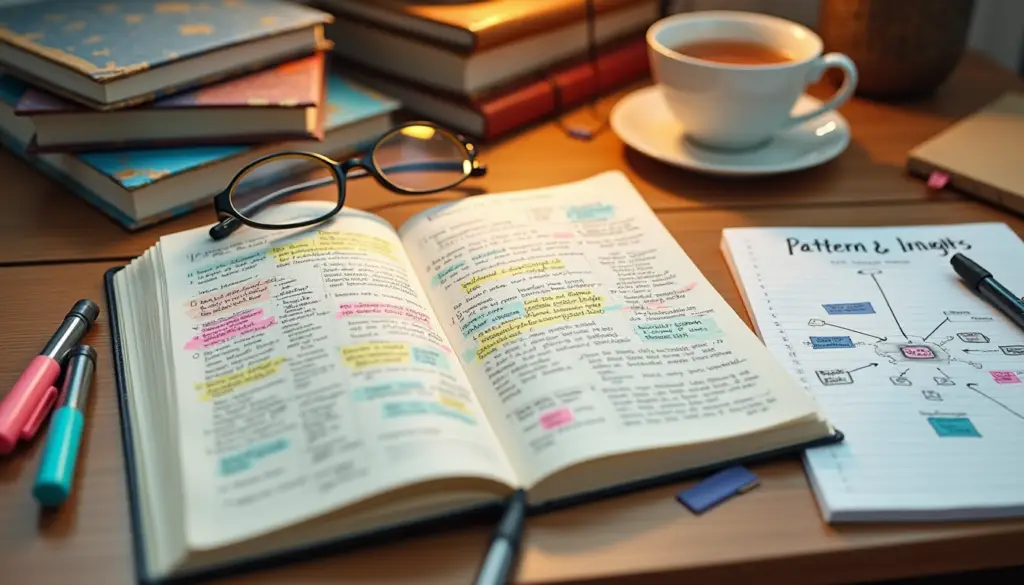Once you’ve established a consistent journaling practice, you may find yourself ready to explore more sophisticated approaches. Advanced journaling techniques can deepen self-awareness, accelerate personal development, and unlock insights that might remain hidden with more basic approaches. This guide explores methods designed for experienced journalers seeking to enhance their practice.


Standard journaling often involves recording events and immediate reactions. Advanced reflection takes this further by analyzing recurring themes, identifying behavioral patterns, and connecting seemingly unrelated elements of your life.
The Five Whys: Borrowed from root cause analysis in business, this technique involves asking “why” five times in succession to uncover deeper motivations behind behaviors or feelings. For example:
This process often reveals underlying beliefs or values that wouldn’t be apparent from surface-level reflection.
Temporal Analysis: Review entries from different time periods—perhaps comparing seasonal patterns, responses to similar situations across years, or entries written during different life phases. This longitudinal view reveals how you’ve evolved and which patterns have remained consistent over time.
Perspective Shifting: Rewrite a significant event from an alternative viewpoint. This might be another person’s perspective, your future self looking back, or even writing as if you were an impartial observer. This technique builds empathy and provides fresh insights into situations where you may be too emotionally involved.


Combining journaling with mindfulness practices creates a powerful synergy that enhances self-awareness and emotional regulation.
Pre-meditation Journaling: Before meditating, briefly document your current mental state, physical sensations, and predominant thoughts. This creates a baseline awareness and helps identify what patterns to observe during meditation.
Post-meditation Reflection: Immediately after meditation, record insights that arose during your practice. This captures subtle realizations that might otherwise fade quickly.
“The journal can become a mirror, reflecting your inner landscape with increasing clarity. It’s a trusted companion on your journey to greater mindfulness and self-understanding.” — Write Your Way
Body Scan Journaling: Working systematically from head to toe (or vice versa), write about physical sensations in each body part and any emotions or memories connected to these sensations. This practice enhances the mind-body connection and often reveals emotional states held in the body before they reach conscious awareness.
Mindful Observation: Select an ordinary object and describe it in extraordinary detail, noting texture, color variations, sensory qualities, and your reactions to it. This exercise strengthens the capacity for focused attention that transfers to self-observation.
Advanced journaling often involves creating internal conversations that access different aspects of wisdom and perspective within yourself.
Inner Council: Identify different “voices” or aspects of yourself (e.g., the Inner Critic, the Compassionate Self, the Creative Child, the Wise Elder). Write dialogues between these perspectives to work through complex issues, utilizing the unique wisdom each part offers.
Unsent Letters: Write letters you’ll never send to process complicated relationships or unresolved situations. This might include letters to people from your past, future self, younger self, or even to abstract concepts like your illness, fear, or a difficult emotion.
Dialogue with the Obstacle: When facing a challenge, personify it and engage in written conversation. Ask why it exists, what it wants, what it might be protecting, and how you might collaborate rather than fight against it.
“Zoe stared at the blinking cursor on her laptop screen, the blank document a stark reminder of her writer’s block. She’d been trying to start her novel for months, but the words wouldn’t come. With a frustrated sigh, she closed her laptop and reached for the leather-bound journal her best friend had given her for her birthday.” — Write Your Way

Advanced journaling can serve as a powerful tool for intentional life design, moving beyond simple goal tracking to comprehensive life architecture.
Values Clarification: Systematically explore your core values through specific prompts and exercises. Once identified, regularly review decisions and goals against these values to ensure alignment.
Future Autobiography: Write your life story as you hope it will unfold, from the perspective of your future self looking back. This exercise clarifies long-term vision while providing emotional connection to desired outcomes.
Decision Matrices: For complex decisions, create written frameworks that weigh options against multiple criteria, including both practical considerations and alignment with personal values.
Quarterly Life Review: Institute a formal, written review process every three months, evaluating progress in key life domains, celebrating wins, analyzing setbacks, and setting intentions for the coming quarter.
Advanced journaling often involves combining writing with other growth-oriented approaches for enhanced results.
Therapy Integration: Use your journal to prepare for therapy sessions by identifying topics to discuss, then afterward to capture insights and continue processing between appointments.
Reading Response: Maintain a dialogue with influential books by documenting how concepts apply to your specific circumstances, experiments with recommended practices, and results observed.
Habit Tracking and Analysis: Move beyond simple habit tracking to analyze the psychological and contextual factors that influence your behavior patterns. Document environmental triggers, emotional states, and intervention strategies that affect habit adherence.
Shadow Work: Specifically journal about aspects of yourself you typically deny, reject, or hide. Regular exploration of these “shadow” elements often leads to greater wholeness and reduced internal conflict.
“Reflective journaling is more than a record of your life; it’s a tool for transformation and self-discovery.” — The Art of Journaling
As your practice matures over years or decades, specific approaches maximize the value of this extended written record.
Periodic Time Capsules: Create comprehensive “snapshots” of your life at regular intervals—perhaps on birthdays or New Year’s. Include current priorities, challenges, joys, and predictions for the future. These entries become invaluable reference points when reviewed years later.
Legacy Journaling: Intentionally document wisdom, stories, and insights you wish to pass on to others. This might include family history, hard-won life lessons, or values you hope to transmit across generations.
Meta-Journaling: Periodically write about your journaling practice itself—how it’s evolved, what you’ve learned, how different techniques have served you, and adjustments you might make going forward.
Archiving System: Develop a thoughtful approach to preserving and organizing your journals. This might include digitization, proper physical storage, or even selective curation of entries into thematic collections.


Even experienced journalers encounter periods of resistance or diminished insight. Advanced practitioners develop specific techniques for these challenges.
Dialogue with Resistance: When you notice reluctance to write or explore certain topics, write a conversation with this resistance. Ask what it’s protecting, what it needs, and how you might address its concerns while still moving forward.
Experimental Formats: When your usual methods feel stale, introduce radical format changes—perhaps writing in third person, creating visual mind maps, using color coding, or adopting entirely new structures.
Guided Inquiry Partnerships: Work with a trusted friend or coach who provides personalized prompts based on your current challenges or growth edges. Outside perspective often illuminates blind spots that self-directed journaling might miss.
Deliberate Contrast: When feeling stuck, intentionally write from an opposing viewpoint or contrary position to your usual perspective. This cognitive flexibility exercise often breaks through entrenched thinking patterns.
Advanced journaling is not about complexity for its own sake, but about developing a practice sophisticated enough to meet your evolving needs. The techniques described here represent starting points rather than rigid prescriptions.
The most powerful advanced practice is one that remains responsive—to your current life phase, immediate challenges, and long-term growth trajectory. Regular meta-reflection on your journaling itself ensures that your practice continues to serve your development rather than becoming formulaic.
Remember that the goal of advanced journaling is not perfection but expansion—of self-awareness, possibilities, and perspective. By thoughtfully incorporating these techniques into your established practice, you create a powerful vehicle for continued growth throughout life’s journey.
As you explore these advanced approaches, maintain the foundational elements that make journaling valuable: honesty, consistency, and the willingness to surprise yourself with what emerges on the page. The most profound insights often arise not from technique alone, but from the authentic dialogue between your conscious mind and the deeper wisdom that emerges through the act of writing.